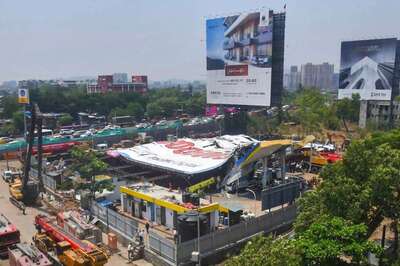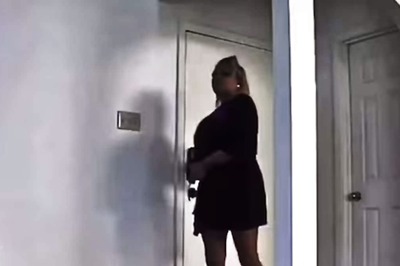
views
Patna: From dramatic performances near the iconic Golghar to a chess competition at a city school, Durga Puja in 1930-era Patna was a cultural affair to romance, far different from the social milieu that exist today in the Bihar capital. While many old-timers still recall the musical soirees that played out from dusk to dawn in the streets in the 60s and early 70s, the memories of colonial-era puja festivities have practically faded.
However, rare personal archives associated with the legendary Quila House of Patna city, are helping give a peek into the Puja festivities of the pre-Independence era. Aditya Jalan, 43, the current scion of the Jalan family has chanced upon boxes of letters and festive greetings cards which were sent to his great grandfather Radha Krishna Jalan, a businessman and a well-known personality of his period.
“We have found some of the very rare Durga Puja greetings of 1936 sent by the then zamindar families of Ammawan and Ranka (now in Jharkhand’s Palamu district), and also from Maharaja Sir Mohan Shamsher Jang Bahadur Rana, who was the prime minister of Nepal from 1948-51. Interesting part is all three cards have a similar look, feel and design,” he told PTI. The Ammawan family card, which carries the Ammawan Raj (in Gaya district) crest on the front cover, was printed by Thacker, Spink and Company of Calcutta.
“All three cards have a beautiful image of Maa Durga slaying the demon Mahisasur, and of other deities, as one would see in a pandal, with a Durga Stuti printed below it. The Raja of Ranka card also has an image of Ram-Sita Durbar. All three cards bear ‘Shubh Vijaya’ Dusshera greetings on the cover in a very aesthetic font. This is priceless, and tell us how people celebrated in that era,” said Jalan, the proud possessor of the collection. He said there are a few cards from the famous Darbhanga Raj family too, and one from the 1930s even has a photograph of the iconic Vishwavilas Palace, popularly known as Bela Palace which presently houses the Postal Training Centre in Darbhanga, printed inside. Dusshera greetings are printed in English on the right face of the card inside.
Patna-born Jalan, an avid archivist too, recalls Puja during his childhood days when the sprawling campus of the over a century-old iconic Quila House was let out by his family to various committees for cultural events. “But, look how people celebrated Puja in 1930s and perhaps in the decades nearing it. There were theatre performances and sports and music events and these documents sort of help us imagine Patna of that era too, as not much visual documentation of the city is publicly available,” he said.
An October 1936 invitation card issued by The Friends’ Dramatic Association, Bankipur, mentions: “the dramatic performances to be staged on the occasion of Sri Durga Puja at 9:30 pm, near Golghar (Maidan)”. The three plays are — “Mashraqi Hur (Oct 4), Asir-e-Hirs (Oct 5) and Swami Bhakt (Oct 6),” the card says.
Another 1936 Puja invitation card sent to Radha Krishna Jalan, addressing him as Rai Bahadur, by the Patna Blind School’s Head Master, mentions a four-day programme list, which includes a chess contest, Gita competition, an ‘arati’ and a music competition. Interesting coincidence is that Dusshera in 1936 had also fallen on October 25, the same date as for 2020, which is seeing subdued festivities due to the COVID-19 pandemic.
Aditya said that he also has in his possession an invitation card of October 1936, sent to his great grandfather, for the opening of the Bharat Mata Mandir in Varanasi on Vijaya Dashmi day (October 25). It was inaugurated by Mahatma Gandhi in the campus of the Kashi Vidyapith. The city of Patna had tryst with cultural affairs during Durga Puja in 60s too, when music legends like shehnai player Ustad Bismillah Khan, sitar player Ustad Vilayat Khan, violinist V G Jog, danseuse Sitara Devi, and a constellation of great singers from the film industry, such as Mohammed Rafi, Talat Mahmood and Manna Dey, regaled the crowd, year after year.
Kolkata-based Rajiv Soni, 67, who grew up in Patna, recalled how the Bihar capital was a “hub of culture” that attracted big stars and “patronised them while celebrating culture”. “In the 60s, as a kid, I used to go with my parents in our Ambassador car to some of the famous musical gatherings which were hosted across the city, from Langertoli to Gardanibagh and Machchuatoli to Lodipur,” he told PTI.
Soni, taking a trip down memory lane, said, people watched and listened to them in rapt attention, as “they were spellbound” by the performances that went from late evening to the crack of dawn. “Such was the charm and allure of Patna, now it’s all gone, decades of cultural decay in the city,” he rued.
His friend and a native of Patna, Kamal Sahi, 68, recalls the Qawwali performances that were hosted in Musallahpur Hat area, and the evening soirees at Langertoli and area opposite Biscomaun Bhawan, whole night. Patna resident Asha Prasad, 68, who once went to an event as a child, said, “Huge banners would be put up in the city, venues were well-decorated and no one whistled or ill-behaved”.
Disclaimer: This post has been auto-published from an agency feed without any modifications to the text and has not been reviewed by an editor
Read all the Latest News and Breaking News here


















Comments
0 comment